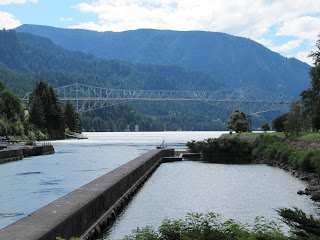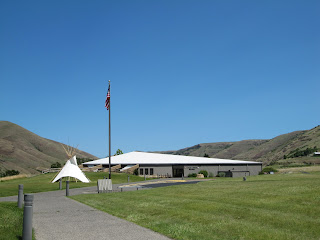What an amazing Christmas present Cassie Simpson received
in 1906! Her husband, lumber baron and shipping tycoon Louis J. Simpson, gifted
her with a splendid mansion on a high promontory overlooking the Pacific Ocean
near Cape Arago on the southern Oregon Coast. It must have been a challenge to
wrap with its heated indoor pool, huge stone fireplace, myrtlewood wall
paneling, and 2700-square foot ballroom.
What began as a summer home eventually became their
fulltime residence as art work, riding stables, tennis courts, and a Roman bath
were added to the property. Louis had a strong interest in developing a formal
garden. The rich soil and coastal, temperate climate created perfect growing
conditions, and soon hydrangeas and roses were supplemented with exotic plants
from around the world delivered via his ships.
Sadly, Cassie died in 1921 and later that year the entire
house burned to the ground. Six years later, an even grander replacement
mansion was constructed on the site, but the realities of the approaching financial
Depression of the 1930s drained Simpson’s resources. The house was never
completed and gradually fell into disrepair. The property was sold to the state
of Oregon in 1942 and, during World War II, was used as a barracks for soldiers.
After the war, the house was torn down but the formal
garden, gardener’s cottage, and spectacular view remained to become Shore Acres
State Park. The park, located 13 miles south of Coos Bay/North Bend, occupies a
three-mile stretch of coastline between Sunset Bay and Cape Arago. On the site
where the Simpsons’ mansion once stood is a glass-enclosed observation building.
This is a great spot for viewing wild, winter waves and migrating whales while
staying dry and out of the wind.
Trails to the north and south offer more dramatic views
of the surf and tilted layers of exposed rock where wave erosion has created
unusual holes and knobs on the sandstone cliffs. Slightly south of the park, a
new interpretive overlook offers views to Shell Island and Simpson Reef. Noisy,
barking seals, sea lions, and elephant seals can be seen year-round, and gray
whales travel along the coast here from December to June.
Competing with this rugged seascape is a remarkable
seven-acre botanical garden. Carefully
manicured and maintained, it offers a long season of blooms starting with
spring bulbs and tulips (over 8,000), azaleas, and rhododendrons. Later, roses and other perennials and annuals
provide summer color while dahlias take center stage in the early fall. There
is also a Japanese-style garden with a lily pond guarded by a pair of bronze
herons, and a 95-foot tall Monterey pine dating back to the original estate. An
extensive gift shop at the garden’s entrance offers many gardening related items
and crafts made by local artisans.
Beginning in 1987, the non-profit Friends of Shore Acres
started an annual Christmas tradition of decorating the garden with lights.
Today it takes 1500 volunteers to string 300,000 lights around trees and shrubs
and 26 holiday trees. Large sculptures shaped by lights include a whale,
jellyfish, frog, Dungeness crab, butterflies, and even underwater koi fish in
the lily pond. Refreshments and musical entertainment complete the holiday
experience. Last year this community event drew 47,000 visitors from 28
countries and 45 states to this remote section of the Oregon Coast. This year’s
display will begin November 28 and run through December 31.

.JPG)










+016.JPG)
+006.JPG)
+020.JPG)

























